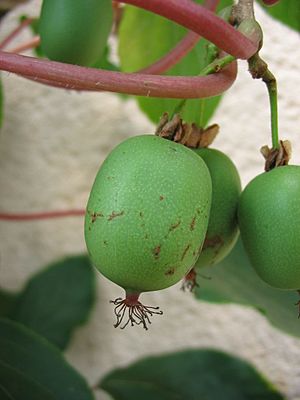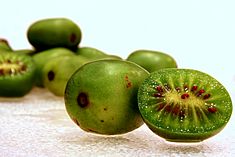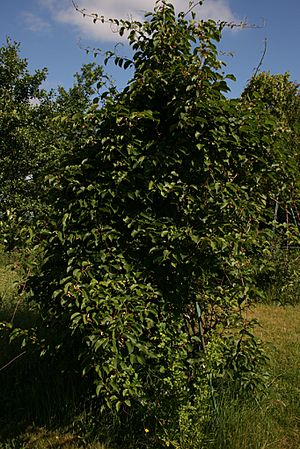Hardy kiwi facts for kids
Quick facts for kids Hardy kiwi |
|
|---|---|
 |
|
| Scientific classification | |
| Genus: |
Actinidia
|
| Species: |
arguta
|
The hardy kiwi (scientific name: Actinidia arguta) is a cool plant that grows like a vine. It comes from places like Japan, Korea, Northern China, and the Russian Far East. This vine grows a small fruit that looks a lot like a regular kiwi, but it doesn't have the fuzzy skin. You can eat the whole thing!
Contents
What is a Hardy Kiwi?
The fruit of the hardy kiwi has many fun names like Siberian gooseberry, baby kiwi, or cocktail kiwi. It's about the size of a berry or a grape. It tastes a lot like a regular kiwi, but it's often sweeter.
Hardy kiwis can be green, brownish, or even purple. Sometimes they have a red blush on their smooth skin. The best part is you don't need to peel them! You can just pop them in your mouth and enjoy.
History of the Hardy Kiwi
Scientists first described the hardy kiwi way back in 1843. Two scientists, Philipp Franz von Siebold and Joseph Gerhard Zuccarini, gave it its first name. Later, in 1867, another scientist named Friedrich Anton Wilhelm Miquel moved it into the Actinidia group, which is where regular kiwis belong too.
There are different types of hardy kiwis, called cultivars. Some popular ones you might hear about include 'Ananasnaya', 'Geneva', 'MSU', 'Weiki', 'Jumbo Verde', and 'Rogow'. There's also a special type called 'Issai' which is a mix of two different kiwi plants.
Growing Hardy Kiwis
Hardy kiwi vines grow very fast and can climb high. They are called "hardy" because they can survive cold temperatures, even down to -34°C (-30°F)! However, new shoots in spring can be hurt by frost. These plants need about 150 days without frost to grow fruit. They also need a cold winter period to grow well.
You can grow hardy kiwis from seeds, but it takes about a month for them to sprout. Another way is to use cuttings, which are pieces of an existing plant. These cuttings can be planted directly or attached to other kiwi plant roots.
When people grow hardy kiwis at home, they often use a trellis. This is a frame that helps the vines grow sideways, making it easier to take care of them and pick the fruit. These vines grow super fast, sometimes up to 20 feet in one year! So, they need a very strong trellis. For farms, it's best to plant them where they get lots of sunlight, even though they can handle some shade. Hardy kiwi plants also need a lot of water and grow best in soil that drains well and is a bit acidic.
Pollination and Harvest
For the vines to grow fruit, you usually need both male and female plants. The male plant helps pollinate the female plants, allowing them to produce fruit. One male plant can help six female plants make fruit! Flowers usually appear in late spring, around the third year of the plant's life. If the flowers get frozen, there won't be any fruit that year.
Hardy kiwis are usually harvested in the autumn. The exact time depends on where they are grown and the specific type of plant. Each vine can produce a lot of fruit, sometimes up to 100 pounds per year! On average, it's about 50 pounds per vine. The fruit gets sweeter if it ripens on the vine.
Pests and Problems
Hardy kiwi vines can get some plant diseases, like root rot, which is the most serious problem. They can also be bothered by tiny pests like spider mites and Japanese beetles.
Interestingly, cats really love hardy kiwi vines! The plants have a smell that's a bit like catnip. Cats might try to dig up the roots or damage the vines because of this smell.
Commercial Growing
It has been tricky to sell hardy kiwis widely because they don't last long after being picked. However, people are working hard to change this. Now, hardy kiwis are being grown on a smaller scale in places like South America, New Zealand, Europe, Canada, and parts of the United States (like Oregon and Washington).
Eating Hardy Kiwis

A hardy kiwifruit cut in half and some whole ones.
|
|
| Nutritional value per 100 g (3.5 oz) | |
|---|---|
| Energy | 322 kJ (77 kcal) |
|
18 g
|
|
| Sugars | 7.6 g |
| Dietary fiber | 3 g |
|
0.6 g
|
|
|
Protein
|
1.2 g
|
| Vitamins | Quantity
%DV†
|
| Vitamin C |
112%
93 mg |
| Minerals | Quantity
%DV†
|
| Potassium |
10%
288 mg |
| Sodium |
0%
6 mg |
| †Percentages estimated using US recommendations for adults. Source: NZ KiwiBerry Growers Inc. Nutrional Value |
|
Hardy kiwis are great for eating fresh, but they can also be used to make jam.
-
Hardy kiwi jam.
In Korea
In Korea, hardy kiwi is called darae (다래). The young leaves of the plant, called darae-sun, are often cooked as a vegetable dish called namul.
In Russia
In the Russian Far East, hardy kiwi is known as kishmish. It's a very popular fruit that people buy at farmer's markets when it's in season.
Hardy Kiwis in the United States
Hardy kiwi plants have been grown in the northeastern United States for over 100 years. Recently, some groups have noticed that these vines can grow very quickly and sometimes take over other plants and trees in certain areas. This means they might become an invasive species, which is a plant that spreads too much and harms the local environment. Scientists are watching these plants to see if they pose a bigger risk.
Ancient Hardy Kiwis
Scientists have found very old remains of hardy kiwi plants from a time called the early Pliocene epoch. These ancient plant parts were found in western Georgia, in a region called the Caucasus. This shows that hardy kiwis have been around for a very long time!
See also
 In Spanish: Actinidia arguta para niños
In Spanish: Actinidia arguta para niños







